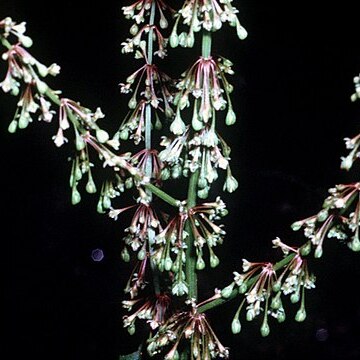Plants perennial, glabrous or nearly so, with vertical rootstock. Stems erect or, rarely, ascending, simple or producing axillary shoots below 1st-order inflores-cence or at proximal nodes, 40-100(-150) cm. Leaf blades with lateral veins forming angle of 45-60° with midvein, linear-lanceolate or lanceolate, 5-30(-40) × 1-5 cm, usually 5-7(-10) times as long as wide, normally rather thin or at most subcoriaceous, base narrowly cuneate, margins entire, flat or slightly undulate, apex acute or acuminate. Inflorescences terminal and axillary, terminal usually occupying distal 1/ 1/ 2 of stem, usually lax, interrupted at least in basal 2, narrowly paniculate. Pedicels articulated in proximal part, distinctly thickened distally, 10-17 mm, (2.5-)3-5 times as long as inner tepals, articulation distinctly or slightly swollen. Flowers 10-15(-25) in remote whorls; inner tepals ovate-triangular or ovate-deltoid, 3.5-5 × 2.5-4 mm, longer than wide or, very rarely, as long as wide, base truncate or rounded, margins entire or, rarely, very indistinctly erose, apex acute or subacute (then with broadly triangular-lingulate tip); tubercles 3, equal or subequal, minutely punctate and/or transversely rugose (wrinkled) in proximal part. Achenes brown or dark brown, 2.3-3.1 × 1.6-2.2 mm. 2n = 60.
More
Stout, taprooted, glabrous perennial to 1.5 m, with many short axillary branches; lvs flat, lanceolate or lance-linear, narrowed to the base; infl 2–4 dm, with usually few ascending leafless branches, the verticils becoming contiguous in the upper half, pedicels straight, slender, 10–15 mm, deflexed, jointed near the base; valves broadly triangular-ovate, 3.5–6 mm, nearly or fully as wide, or even a little wider than long, obtuse, truncate at base, very thick toward the center; grains 3, lanceolate, two-thirds as long as the valve, the blunt base projecting 0.5 mm below the valve; 2n=60. Swamps and wet lowland woods; Que. and Ont. to Wis. and Kans., s. to Fla. and Tex. (R. floridanus)

